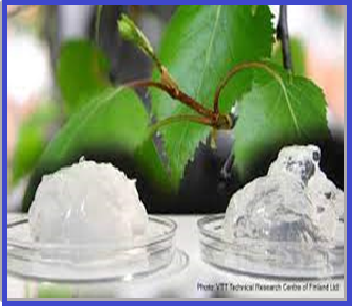Review Article: Development of biodegradable films using nanocellulose for food packaging application
Volume 5, Issue 04, Pages 20-42, Dec 2022 *** Field: Analytical Chemistry in Food
Abstract
Due to the development of nanotechnology and changing customer demands for food safety and hygiene, the food packaging industry is growing significantly. In today's worldwide market, active packaging offers a number of advantages over traditional wrapping because of its capacity to absorb or release substances to improve the shelf life of food. Traditional food packaging materials are difficult to recycle and are made from nonrenewable fossil fuels. The development of biodegradable films using Nano cellulose can be a good replacement for synthetic plastic packaging materials and can be a good solution for this problem. Other than that it has multiple advantages regarding tensile and physical properties, also as reducing health hazards. Tensile and physical characteristics are improved and water vapor permeability is decreased with the addition of cellulose nanoparticles to the biodegradable films/biodegradable composite films. The production of biodegradable materials employing Nano cellulose has been covered in this review study in four different ways, including extracts from agricultural waste, rice husk, various plant extracts, and biopolymer composite material in food packaging. The reason for using Nano cellulose-based biodegradable films in food packaging is also reviewed in this article. The key points for future research related to Nanocellulose and biodegradable films.
References
S. Nanda, F. Berruti, Municipal solid waste management and landfilling technologies: a review, Environ. Chem. Lett., 19 (2021) 1433-1456. https://doi.org/10.1007/s10311-020-01100-y.
S.H. Gebre, M.G. Sendeku, M. Bahri, Recent trends in the pyrolysis of non‐degradable waste plastics, Chem. Open, 10 (2021) 1202-1226. https://doi.org/10.1002/open.202100184.
C. Amara, A. El Mahdi, R. Medimagh, K. Khwaldia, K. Nanocellulose-based composites for packaging applications, Curr. Opin. Green Sustain. Chem., 31 (2021) 100512. https://doi.org/10.1016/j.cogsc.2021.100512.
J.R. Pires, V.G.L.D. Souza, A.L. Fernando, Production of nanocellulose from lignocellulosic biomass wastes: prospects and limitations, In International Conference on Innovation, J. Eng. Entrep., 505 (2018, June) 719-725. https://doi.org/10.1007/978-3-319-91334-6_98.
V. Katinas, M. Marčiukaitis, E. Perednis, E.F. Dzenajavičienė, Analysis of biodegradable waste use for energy generation in Lithuania, Renew. Sustain. Energ. Rev., 101 (2019) 559-567. https://doi.org/10.1016/j.rser.2018.11.022.
L.K. Ncube, A.U. Ude, E.N. Ogunmuyiwa, R. Zulkifli, I.N. Beas, Environmental impact of food packaging materials: A review of contemporary development from conventional plastics to polylactic acid based materials, Materials, 13 (2020) 4994. https://doi.org/10.3390/ma13214994.
G.K. Gupta, P. Shukla, Lignocellulosic biomass for the synthesis of nanocellulose and its eco-friendly advanced applications, Front. Chem., 8 (2020) 1203. https://doi.org/10.3389/fchem.2020.601256.
S. Mondal, Chapter11, Nanocellulose reinforced polymer nanocomposites for sustainable packaging of foods, cosmetics, and pharmaceuticals, Sustainable nanocellulose and nanohydrogels from natural sources, Elsevier, Micro Nano Technol., (2020) 237-253. https://doi.org/10.1016/b978-0-12-816789-2.00011-0.
P. Phanthong, P. Reubroycharoen, X. Hao, G. Xu, A. Abudula, G. Guan, Nanocellulose: extraction and application, Carbon Resour. Convers., 1 (2018) 32–43. https://doi.org/10.1016/j.crcon.2018.05.004.
M. Hietala, K. Varrio, L. Berglund, J. Soini, K. Oksman, Potential of municipal solid waste paper as raw material for production of cellulose nanofibres, Waste Manage., 80 (2018) 319-326. https://doi.org/10.1016/j.wasman.2018.09.033.
J. Pennells, I.D. Godwin, N. Amiralian, D.J. Martin, Trends in the production of cellulose nanofibers from non-wood sources, Cellulose, 27 (2020) 575-593. https://doi.org/10.1007/s10570-019-02828-9.
A.K. Rana, E. Frollini, V.K. Thakur, Cellulose nanocrystals: Pretreatments, preparation strategies, and surface functionalization, Int. J. Biol. Macromol., 182 (2021) 1554-1581. https://doi.org/10.1016/j.ijbiomac.2021.05.119.
C. Sharma, N.K. Bhardwaj, Bacterial nanocellulose: Present status, biomedical applications and future perspectives, Mater. Sci. Eng. C, 104 (2019) 109963. https://doi.org/10.1016/j.msec.2019.109963.
D. Abol-Fotouh, M.A. Hassan, H. Shokry, A. Roig, M.S. Azab, A.E.H.B. Kashyout, Bacterial nanocellulose from agro-industrial wastes: Low-cost and enhanced production by Komagataeibacter saccharivorans MD1, Sci. reports, 10 (2020) 1-14. https://doi.org/10.1038/s41598-020-60315-9.
E. Souza, L. Gottschalk, O. Freitas-Silva, Overview of nanocellulose in food packaging, Recent Pat. Food Nutr. Agric., 11 (2020) 154-167. https://doi.org/10.2174/2212798410666190715153715.
C. Maraveas, Production of sustainable and biodegradable polymers from agricultural waste, Polymers, 12 (2020) 1127. https://doi.org/10.3390/polym12051127 www.mdpi.com/journal/polymers.
A.N.S. Ahmad Khorairi, N.S. Sofian-Seng, R. Othaman, H. Abdul Rahman, N.S. Mohd Razali, S.J. Lim, W.A. Wan Mustapha, A review on agro-industrial waste as cellulose and nanocellulose source and their potentials in food applications, Food Rev. Int., (2021) 1-26. https://doi.org/10.1080/87559129.2021.1926478.
S.J. Owonubi, S.C. Agwuncha, N.M. Malima, G.B. Shombe, E.M. Makhatha, N. Revaprasadu, Non-woody biomass as sources of nanocellulose particles: A review of extraction procedures, Front. Energ. Res., 9 (2021) 608825. https://doi.org/10.3389/fenrg.2021.608825.
J.P. Greene, Automotive plastics and composites: Materials and processing, William Andrew, Elsevier, (2021) 191-222. https://doi.org/10.1016/B978-0-12-818008-2.00007-6.
R.A. Ilyas, S.M. Sapuan, R. Ibrahim, H. Abral, M.R. Ishak, E.S. Zainudin, R. Jumaidin, Effect of sugar palm nanofibrillated cellulose concentrations on morphological, mechanical and physical properties of biodegradable films based on agro-waste sugar palm (Arenga pinnata (Wurmb.) Merr) starch, J. Mater. Res. Technol., 8 (2019) 4819-4830. https://doi.org/10.1016/j.jmrt.2019.08.028.
A.N. Frone, D.M. Panaitescu, I. Chiulan, A.R. Gabor, C.A. Nicolae, M. Oprea, A.C. Puitel, Thermal and mechanical behavior of biodegradable polyester films containing cellulose nanofibers, J. Therm. Anal. Calorim., 138 (2019) 2387-2398. https://doi.org/10.1007/s10973-019-08218-4.
R. Reshmy, E. Philip, P.H. Vaisakh, S. Raj, S.A. Paul, A. Madhavan, A. Pandey, Development of an eco-friendly biodegradable plastic from jack fruit peel cellulose with different plasticizers and Boswellia serrata as filler, Sci. Total Environ., 767 (2021) 144285. https://doi.org/10.1016/j.scitotenv.2020.144285.
S. Xu, M. Jiang, Q. Lu, S. Gao, J. Feng, X. Wang, P. Ouyang, Properties of polyvinyl alcohol films composited with hemicellulose and nanocellulose extracted from artemisia selengensis straw, Front. Bioeng. Biotechnol., 8 (2020) 980. https://doi.org/10.3389/fbioe.2020.00980.
R.H. Faradilla, G. Lee, J. Roberts, P. Martens, M. Stenzel, J. Arcot, Effect of glycerol, nanoclay and graphene oxide on physicochemical properties of biodegradable nanocellulose plastic sourced from banana pseudo-stem, Cellulose, 25 (2018) 399-416. https://doi.org/10.1007/s10570-017-1537-x.
D.S. Kocabaş, M.E. Akçelik, E. Bahçegül, H.N. Özbek, Bulgur bran as a biopolymer source: Production and characterization of nanocellulose-reinforced hemicellulose-based biodegradable films with decreased water solubility, Ind. Crop. Prod., 171 (2021) 113847. https://doi.org/10.1016/j.indcrop.2021.113847.
K. Pavalaydon, H. Ramasawmy, D. Surroop, Comparative evaluation of cellulose nanocrystals from bagasse and coir agro-wastes for reinforcing PVA-based composites, Environ. Dev. Sustain., 24 (2022) 9963-9984. https://doi.org/10.1007/s10668-021-01852-9.
V. Nang An, C. Nhan, H. Thuc, T.D. Tap, T.T.T. Van, P. Van Viet, L. Van Hieu, Extraction of high crystalline nanocellulose from biorenewable sources of Vietnamese agricultural wastes, J. Polym. Environ., 28 (2020) 1465-1474. https://doi.org/10.1007/s10924-020-01695-x.
H. Li, H. Shi, Y. He, X. Fei, L. Peng, Preparation and characterization of carboxymethyl cellulose-based composite films reinforced by cellulose nanocrystals derived from pea hull waste for food packaging applications, Int. J. Biol. Macromol., 164 , (2020) 4104-4112. https://doi.org/10.1016/j.ijbiomac.2020.09.010.
J.S. Yaradoddi, N.R. Banapurmath, S.V. Ganachari, M.E.M. Soudagar, N.M. Mubarak, S. Hallad, H. Fayaz, Biodegradable carboxymethyl cellulose based material for sustainable packaging application, Sci. reports, 10 (2020) 1-13. https://doi.org/10.1038/s41598-020-78912-z.
P. Nascimento, R. Marim, G. Carvalho, S. Mali, Nanocellulose produced from rice hulls and its effect on the properties of biodegradable starch films, J. Mater. Res., 19 (2016) 167-174. https://doi.org/10.1590/1980-5373-mr-2015-0423.
S. Rashid, H. Dutta, Characterization of nanocellulose extracted from short, medium and long grain rice husks, Ind. Crop. Prod., 154 (2020) 112627. https://doi.org/10.1016/j.indcrop.2020.112627
J.F. Delgado, O. de la Osa, A.G. Salvay, E. Cavallo, P. Cerrutti, M.L. Foresti, M.A. Peltzer, Reinforcement of yeast biomass films with bacterial cellulose and rice Husk cellulose nanofibres, J. Polym. Environ., 29 (2021) 3242-3251. https://doi.org/10.1007/s10924-021-02109-2.
J.J. Jayaraj, K. Renugadevi, P. Prakash, M. Harish, R.D. Kumar, Effect of nanocellulose extracted from rice husk on the film properties of native starch based edible films, In AIP Conference Proceedings, 2311, AIP Publishing LLC, (2020) 080015. https://doi.org/10.1063/5.0033961.
A. Ganesh Babu, S.S. Saravanakumar, Mechanical and physicochemical properties of green bio-films from poly (Vinyl Alcohol)/nano rice hull fillers, Polym. Bull., 79 (2022) 5365-5387. https://doi.org/10.1007/s00289-021-03757-z.
H. Gupta, H. Kumar, M. Kumar, A.K. Gehlaut, A. Gaur, S. Sachan, J.W. Park, Synthesis of biodegradable films obtained from rice husk and sugarcane bagasse to be used as food packaging material, Environ. Eng. Res., 25 (2020) 506-514. https://doi.org/10.4491/eer.2019.191 eISSN 2005-968X.
R. Reshmy, E. Philip, S.A. Paul, A. Madhavan, R. Sindhu, P. Binod, A. Pandey, A green biorefinery platform for cost-effective nanocellulose production: investigation of hydrodynamic properties and biodegradability of thin films, Biomass convers. Biorefin., 11 (2021) 861-870. https://doi.org/10.1007/s13399-020-00961-1.
M. Sánchez-Gutiérrez, I. Bascón-Villegas, E. Espinosa, E. Carrasco, F. Pérez-Rodríguez, A. Rodríguez, Cellulose nanofibers from olive tree pruning as food packaging additive of a biodegradable film, Foods, 10 (2021) 1584. https://doi.org/10.3390/foods10071584.
M. Asrofi, H. Abral, A. Kasim, A. Pratoto, M. Mahardika, F. Hafizulhaq, Characterization of the sonicated yam bean starch bionanocomposites reinforced by nanocellulose water hyacinth fiber (WHF): the effect of various fiber loading, J. Eng. Sci. Technol., 13 (2018) 2700-2715. https://jestec.taylors.edu.my/
Z. Kassab, M. El Achaby, Y. Tamraoui, H. Sehaqui, R. Bouhfid, Sunflower oil cake-derived cellulose nanocrystals: Extraction, physico-chemical characteristics and potential application, Int. J. Biol. Macromol., 136 (2019) 241-252. https://doi.org/10.1016/j.ijbiomac.2019.06.049.
S. Roy, J.W. Rhim, Gelatin/agar-based functional film integrated with Pickering emulsion of clove essential oil stabilized with nanocellulose for active packaging applications, Colloids and Surf. A: Physicochem. Eng. Asp., 627 (2021) 127220. https://doi.org/10.1016/j.colsurfa.2021.127220.
C. Sharma, N.K. Bhardwaj, P. Pathak, Static intermittent fed-batch production of bacterial nanocellulose from black tea and its modification using chitosan to develop antibacterial green packaging material, J. Clean. Prod., 279 (2021) 123608. https://doi.org/10.1016/j.jclepro.2020.123608.
S.M. Noorbakhsh-Soltani, M.M. Zerafat, S. Sabbaghi, A comparative study of gelatin and starch-based nano-composite films modified by nano-cellulose and chitosan for food packaging applications, Carbohydr. Polym., 189 (2018) 48-55. https://doi.org/10.1016/j.carbpol.2018.02.012.
Y. Montero, A.G. Souza, E.R. Oliveira, D. dos Santos Rosa, Nanocellulose functionalized with cinnamon essential oil: A potential application in active biodegradable packaging for strawberry, Sustain. Mater. Technol., 29 (2021) e00289. https://doi.org/10.1016/j.susmat.2021.e00289.
R. Syafiq, S.M. Sapuan, M.R.M. Zuhri, Antimicrobial activity, physical, mechanical and barrier properties of sugar palm based nanocellulose/starch biocomposite films incorporated with cinnamon essential oil, J. Mater. Res. Technol., 11 (2021) 144-157. https://doi.org/10.1016/j.jmrt.2020.12.091.
V. Lazić, V. Vivod, Z. Peršin, M. Stoiljković, I.S. Ratnayake, P.S. Ahrenkiel, V. Kokol, Dextran-coated silver nanoparticles for improved barrier and controlled antimicrobial properties of nanocellulose films used in food packaging, Food Packag. Shelf Life, 26 (2020) 100575. https://doi.org/10.1016/j.fpsl.2020.100575.
N. Jannatyha, S. Shojaee-Aliabadi, M. Moslehishad, E. Moradi, Comparing mechanical, barrier and antimicrobial properties of nanocellulose/CMC and nanochitosan/CMC composite films, Int. J. Biol. Macromol., 164 (2020) 2323-2328. https://doi.org/10.1016/j.ijbiomac.2020.07.249
A. Nazrin, S.M. Sapuan, M.Y.M. Zuhri, R.A. Ilyas, R.S.F.K.S. Syafiq, S.F.K. Sherwani, Nanocellulose reinforced thermoplastic starch (TPS), polylactic acid (PLA), and polybutylene succinate (PBS) for food packaging applications, Front. Chem., 8 (2020) 213. https://doi.org/10.3389/fchem.2020.00213.
S. Casalini, M. Giacinti Baschetti, The use of essential oils in chitosan or cellulose‐based materials for the production of active food packaging solutions: a review, J. Sci. Food Agric., (2022). https://doi.org/ 10.1002/jsfa.11918.
S.S. Ahankari, A.R. Subhedar, S.S. Bhadauria, A. Dufresne, nanocellulose in food packaging: A review, Carbohydr. Polym., 255 (2021) 117479. https://doi.org/ 10.1016/j.carbpol.2020.117479.
C.G. Perdani, S. Gunawan, A short review: Nanocellulose for smart biodegradable packaging in the food industry, In IOP Conference Series, IOP Publishing, Earth Environ. Sci., 924 (2021) 012032. https://doi.org/ 10.1088/1755-1315/924/1/012032.
U. Qasim, A.I. Osman, A.A.H. Al-Muhtaseb, C. Farrell, M. Al-Abri, M. Ali, D.W. Rooney, Renewable cellulosic nanocomposites for food packaging to avoid fossil fuel plastic pollution: a review, Environ. Chem. Lett., 19 (2021) 613-641. https://doi.org/ 10.1007/s10311-020-01090-x.

JOURNAL PUBLISHING AGREEMENT
PLEASE PROVIDE US THE FOLLOWING INFORMATION,
Article entitled:
Corresponding author:
To be published in the journal:
Your Status
I am the sole author of the manuscript
- I am an Iranian government employee.
- I am a European government employee
- I am a Asian government
- None of the above
I am one author signing on behalf of all co-authors of the manuscript
- I am an Iranian government employee.
- I am a European government employee
- I am a Asian government
- None of the above
Please tick the above blanks (as appropriate), review the Journal Publishing Agreement, and then sign and date the document in black ink.
Published Journal Article: the author may share a link to the formal publication through the relevant DOI. Additionally theses and dissertations which contain embedded Published Journal Articles as part of the formal submission may be hosted publicly by the awarding institution with a link to the formal publication through the relevant DOI. Any other sharing of Published Journal Articles is by agreement with the publisher only.
Signed: ______________________________________ Name printed: ___________________________________________
Title and Company (if employer representative): _______________________Date: __________________________________














